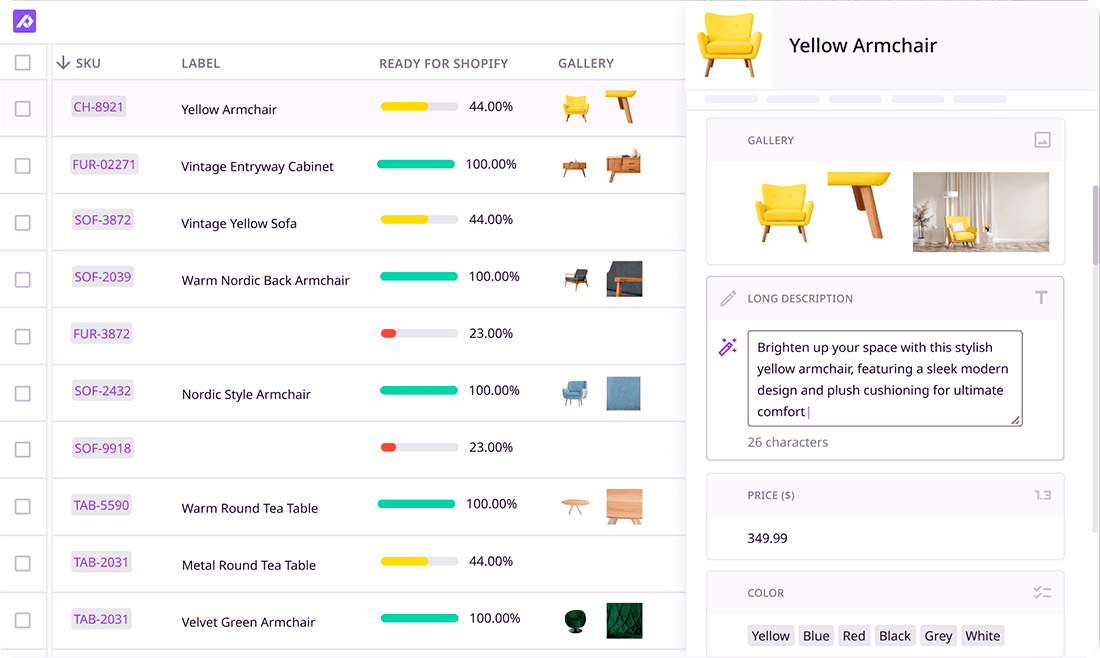
Keep the good stuff coming
Subscribe to our blog newsletter and get monthly content that helps you manage product data smarter.
No spam. Just real value.
There’s no simple answer to how your ecommerce business can reach success. And the key to success in ecommerce will look different for each business. That being said… there is one thing each business must have down to be successful: product experience.
And I’m not talking about the quality or the experience of the physical product. I’m talking about the experience each and every potential customer has with your product when looking to buy. These are the small yet vital details that help the customer feel confident and ready to buy your product online. From quality photos formatted with the right resolution to rich, detailed product descriptions that get your buyers ready to “add to cart,” these elements are what make up a good product experience.
So, as someone who cares about their ecommerce business, you’re going to want to better understand how to win at product experience so that you keep your customers happy and your business thriving. In this article, I’m going to help give you the tools you need to create the best product experience for your customers by exploring what product experience management is and its key elements.
Understanding product experience management (PXM)
So, let me answer the question you’ve actually come here for… What is product experience management?
Product experience management is the strategy and processes (and even tools) you put in place to make sure your product information and media are set up to give your customers the experience they want on the channel they want.
Unsurprisingly, ecommerce is constantly growing, and the online competition continues to grow with it. Customers aren’t short of choice, which is why you need to make sure you’re giving your customers a good product experience. PXM isn’t just the product itself but how it is actually presented, the story it tells, and the emotional connection it develops with customers. Adding PXM to your ecommerce selling strategy is going to give you that competitive edge to make sure customers buy from you and not other businesses.
Product experience management is different from concepts like product lifecycle management (PLM) or product management because it’s a practice focused on the customer, while the other two focus more specifically on the development and supply of products. It’s similar to product information management, but they aren’t exactly the same thing (more on that down below).
Key elements of product experience management
Now that we understand what PXM is, let’s take a look at what the main elements that make up product experience management are. Product experience management can be broken down into four key elements. These elements are the areas you can look at to see how successful you’ll be in creating an impactful product experience for your customers.
Product data management
First and foremost, you have data management. This might not seem like it would be a key factor in how your customers experience your products online, but it’s actually the first fundamental piece you need to be able to create a strong product experience.
You need to have your product data management down so that you can collect, organize, and maintain accurate and optimized product information. That means your product descriptions, pricing, multimedia content, and whatever other product content you have is easily accessible to your team and ready to face your customers. Not only is this important for a better workflow for your team, but it also guarantees consistency across your digital shelf, which ultimately helps build trust with your customers.
Customers don’t want to find erroneous information in the products they want to buy. I mean, think about it: would you like to receive a child-size sofa instead of your brand new (adult-sized) living room sofa all because the company messed up the dimensions in their product description? I can guarantee that you wouldn’t be too happy and that this would be a bad product experience. Give your customers the product experience they deserve, and stay on top of your product data management.
Content creation
But having accurate and consistent product data isn’t enough; you also need to create engaging product content. This is another element you can’t skip out on if you want to give your customers a good product experience. And this isn’t just limited to product descriptions and information, this also includes everything that your customers see—from videos to images, it all needs to engage your customers.
You’ll want to make sure that you bring your products to life and showcase their benefits in a way that resonates with the target audience. This means you’ll need to create content that is engaging, persuasive, and informative. Like I said before, you need to keep it accurate to build customer trust, and you should be cautious about overpromising what your product can do for your customers.
As long as you make sure your images, videos, and product information stay true to your product, all while showcasing its benefits, your customers will get the product experience they want. And just in case you need a little inspiration on how you can write engaging product descriptions, here’s an article on the 5 best product descriptions and why they work to help get your creative juices flowing.
Note: Don’t forget that you have to cater to each sales channel you use to make sure that your product content meets the requirements of that platform. Optimizing your product listings for each channel will not only create a good product experience but will also help get your products to rank higher and reach more customers.
Personalization
Another important aspect in developing your product experience strategy is to tailor your experiences to your customer’s preferences through personalization. A good PXM strategy takes customer data to personalize experiences, showing relevant product recommendations and content that aligns with individual customer interests and past behaviors. This is similar to (and should be done hand-in-hand with) an omnichannel strategy.
Customers truly want you to give them a personalized experience—even to the point where 83% of consumers are willing to share their data to get the benefits of a personalized experience. And we already know how hard it’s becoming to get customer data these days, so if customers are willing to share their data, then we know a personalized product experience means something to them.
Implementing personalized experience across all your channels (*cough* an omnichannel commerce strategy *cough*) give your customers an experience that only used to be possible for brick-and-mortar stores. Your customers get to have the shopping experience that has made so many physical stores successful—a tailored experience just for them.
💡 Tip: You can use PIM or PXM software to create product relationships to make product suggestions for related products and a more personalized experience.
Channel consistency
Consistency is key in PXM. Whether customers are shopping online, on mobile apps, or through social media, the product experience should be uniform and seamless. As I mentioned before, this type of consistency helps in building brand reliability and customer loyalty—your customers will know and trust you.
But you need to be consistent across all your channels—no matter where you sell. This means that however you represent your brand on your webshop, you need to give that same experience on Amazon, eBay, or even Facebook Marketplace. And the same goes for the information and details (pricing, dimensions, etc.) that you give to your customers. Your channel consistency is dependent on your data management.
Being consistent on your channels not only builds a relationship of trust with your customers but it also helps give all of your sales channels a chance to succeed. If one channel is done well, then they all should. To be able to do that, you're probably going to need a tool that can help you with your multichannel listings, like a PIM or feed management tool (or both!).
The intersection of PIM and PXM
Speaking of PIM, product information management as a concept overlaps a lot with PXM. As we saw when looking at the key elements of PXM, storing, managing, optimizing, and distributing your product information and digital assets are extremely important in PXM—and this is exactly what PIM is.
You can use PIM software to execute your PXM strategy. PIM software is a centralized repository for all product-related information, making sure that accurate, optimized, and up-to-date data is available across all sales channels. By using PIM systems, you can improve the quality of your product content, speed up your time-to-market, and improve the overall customer experience. PIM also helps in reducing errors and inconsistencies in product information, which is clearly important for maintaining customer trust and satisfaction (as I’ve mentioned multiple times throughout this article).
If we compare what PIM can do with the four elements of PXM, you’ll see that PIM helps with:
- Data management ✅ (this is the PIM software's strong suit)
- Content creation ✅ (if it has AI or product content creation capabilities)
- Personalization ✅ (you may want to use PIM in combination with marketing software to track and manage customer data)
- Channel consistency ✅
While PIM software may not go by PXM software (some businesses use PIM and PXM interchangeably), many PIM providers are capable of fulfilling your PXM needs. Make sure to create a list of your company needs when buying PIM software (or any software for that matter) to make sure it ticks all of your check boxes of what you need.
Note: If you’re interested in learning more about how PIM and PXM differ, check out this article on PIM vs PXM.
Getting product experience management right
Product Experience Management is no longer just a nice-to-have; it's a necessity in the competitive world of ecommerce. By focusing on PXM, businesses can create meaningful connections with customers, stand out in the market, and drive growth. As technology continues to evolve, the possibilities for enhancing product experiences are limitless. Embracing PXM is not just about selling products; it's about creating memorable experiences that resonate with customers and keep them coming back.
In order to executive your PXM strategies, you’re going to need the right tools to get you there. Check out this free ebook that will help you find the right PIM tool for your PXM strategy. You’ll get a full comparison to make the decision easier for you, so go ahead and grab your copy down below.
Frequently Asked Questions
Product Experience Management (PXM) is a strategic approach in ecommerce focused on delivering compelling, consistent, and personalized product interactions across all digital touchpoints. It encompasses managing and presenting detailed product information, including descriptions, images, videos, and reviews, in a way that resonates with and engages customers.
PXM aims to make sure that every aspect of a product's presentation is optimized to enhance the customer's journey, from discovery to purchase, thereby improving customer satisfaction and driving sales.
The role of product experience in ecommerce is to create a compelling and informative interaction between the customer and the product. It's about presenting products in a way that not only provides the necessary information but also evokes emotions and builds a connection with the shopper.
A good product experience effectively communicates a product's value, encourages customer engagement, and builds trust, which in turn increases the likelihood of conversion and fosters customer loyalty. Essentially, it's about turning the online shopping process into a journey that delights and satisfies the customer at every touchpoint.
A PXM tool is a software solution designed to facilitate the management and optimization of product experiences across various online platforms. It enables businesses to centralize and organize product information, streamline content creation, ensure consistency across channels, and personalize customer interactions.
PXM tools often come with features such as data quality management, workflow automation, content syndication, and analytics, helping brands to effectively manage the end-to-end process of creating compelling product experiences and making sure that their products stand out in a crowded digital marketplace.
Great product experiences are those that seamlessly blend informative content with engaging presentation. For instance, an online store displaying high-resolution, zoomable images alongside immersive 360-degree videos allows customers to virtually experience the product, mimicking an in-store experience. Adding detailed, narrative-driven product descriptions, customer reviews, and personalized recommendations further enriches the experience.
Brands like Apple excel in this, offering intuitive, visually rich product detail pages with clear, concise information, and a seamless path from discovery to purchase.
Another example is Nike's customization options, where customers can design their own shoes, making the shopping experience not just about buying a product but creating something unique.

Bergen Palmer
Bergen Palmer is a content marketer at Plytix, where she writes all about product information and ecommerce. With a background in ecommerce SaaS and content strategy, she focuses on creating clear, trustworthy content that helps brands work better with their product data.

What if your product data actually worked for you?
We’ll show you how Plytix helps you stop fixing data—and start using it.
Related posts
Keep the good stuff coming
Subscribe to our blog newsletter and get monthly content that helps you manage product data smarter.
No spam. Just real value.








Think others should see this?
Go ahead and share it.